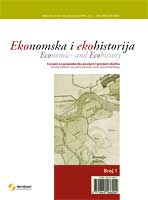PRISTUP EKOHISTORIJI PODRAVINE Prema osmanskim izvorima
APPROACHING THE ECOHISTORY OF THE PODRAVINA According to Ottoman Turkish sources
Author(s): Nenad MoačaninSubject(s): History
Published by: Društvo za hrvatsku ekonomsku povijest i ekohistoriju - Izdavačka kuća Meridijani
Keywords: Podravina; ecohistory; Ottoman Empire
Summary/Abstract: The part of the Podravina region under Ottoman rule was not very homogenous in the administrative, ethnic and religious sense. More than in other confines the borders between the proper borderland and the “civilian” part were extremely fluid, thus producing a kind of “multiple subconfines”. There were probably less inhabitasnts than in the late Middle Ages, which points toward the expansion of forest areas, also suggested by the sources, and, at the same time, toward the increased exploitation of the woods (timber and acorns). Ottoman conquest and the military factor have left a considerable imprint on the landscape (Vlach pastoralization, forced grain production in the flatland), while in the strongholds and marketplaces, notwithstanding the appearance of the mosques as signs of Ottoman-islamic presence, changes were less prominent. The names of places did not considerably change in the 16th century, but later, particularly toward the end of the 17th century, they did to the large extant. Centers of raw material processing (milling), ways of export (wheat, fruit, pigs, slaves) as well the centers of provisioning (wares from the fairs), were all relocated to the southeast (Orahovica, Našice), or to the Middle Danube region (Valpovo and Osijek). The only important regional center was Virovitica, where probably half of the commercial activities of the region were taking place, but the sources give us only some indirect hints thereof.
Journal: Ekonomska i ekohistorija - Časopis za gospodarsku povijest i povijest okoliša
- Issue Year: 2005
- Issue No: 1
- Page Range: 139-146
- Page Count: 8
- Language: Croatian

